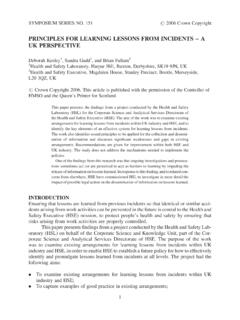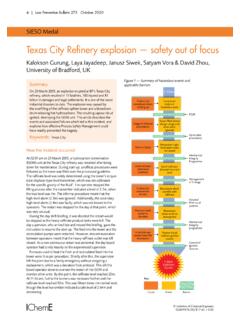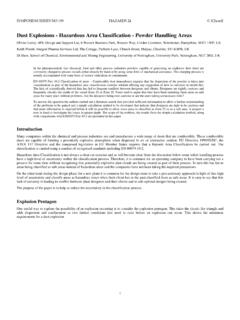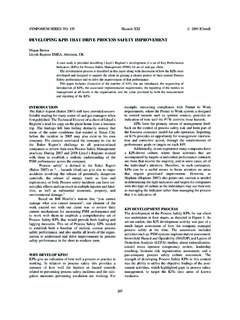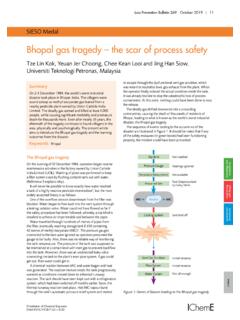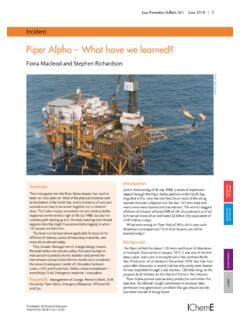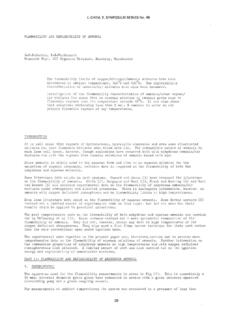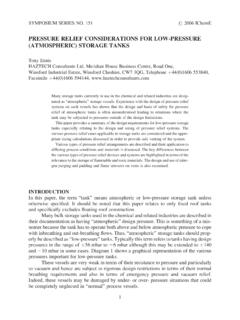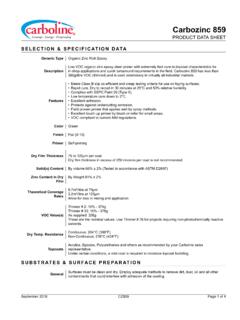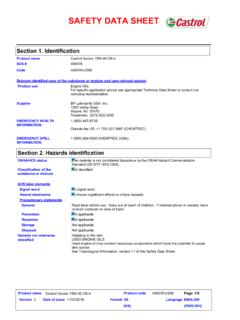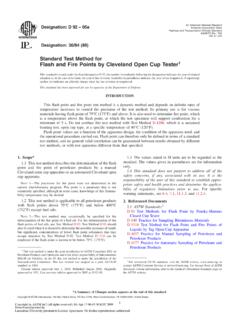Transcription of Flash points of aqueous solutions of flammable solvents
1 Flash points OF aqueous solutions OFFLAMMABLE Astbury1, J. Bugand-Bugandet2, E. Grollet2and StellAvecia Limited, Box 42, Blackley, Manchester M9 8ZS1 Current address: Health & Safety Laboratory, Harpur Hill, Buxton,Derbyshire, SK17 9JN2 Ecole des Mines d Albi, Campus Jarlard, 81013 Albi, Cedex 09, FranceMany fine chemicals and pharmaceutical intermediates are processed usingflammable solvents which are soluble in water. The disposal of such solutions of sol-vents as waste can be problematical, particularly as dilute aqueous solutions can beexpensive to incinerate.
2 Disposal to an effluent treatment plant can be hazardous ifthe solution is above its Flash point. Hence the availability of the Flash point ofaqueous solutions of flammable solvents would be useful for selecting an appropriatedisposal route. Whilst such data of actual measurements of aqueous solutions arevaluable, a predictive method would also be useful, and the data of three solventshave been compared to simple theoretical models, to allow prediction to be under-taken using readily available spreadsheets or calculating tools, rather than using dedi-cated specialist software for physical property prediction.
3 The decision to avoidproprietary prediction software was taken deliberately to make the method easilyapplicable to users in small and medium enterprises (SMEs) who may not haveaccess to such specialised programmes. The correlations obtained were good, withactual Flash points being within 5 K of the predicted values. Tables of measuredvalues are presented for 18 common measurement of Flash point of solutions can be difficult and time consuming. The mostcommon Flash -point apparatus, the pensky -Martens closed -cup Flash point tester1, is suit-able for pure substances, and is not suitable for a two component mixture, as this willchange in composition as the testing proceeds, thus giving a false high Flash -point.
4 There-fore an equilibrium method is required, such as the Setaflash closed Cup method2, or thestandard single-component method must be modified to an equilibrium method. Once flashpoint data is available for several aqueous mixtures of any one solvent, it is comparativelysimple to draw a curve through the known data points and interpolate to any desired , obtaining the initial Flash -point data is time consuming and requires access to theflash-point testing apparatus. Therefore a simple method of predicting the Flash -point of asolution of solvent in water was required, using vapour-liquid equilibrium data and purecomponent Flash -point data readily available in the literature.
5 The approach of using asimple prediction method using the minimum of data is ideal for SMEs who often donot have access to sophisticated physical property data prediction software, and onlyhave access to the open published SERIES No. 150#2004 IChemE1 Flash POINTThe Flash point of a liquid is the temperature at which the liquid has sufficient vapourpressure to just form a flammable atmosphere in equilibrium with the liquid. Clearlyfor a single component, such as acetone, the vapour concentration at the Flash pointcorresponds directly with the lower flammable limit.
6 This will also apply to a multi-component mixture where all the components are , in a binary mixture where one of the components is flammable and theother is water, there is inevitably water vapour present as well as the flammable there is a small quantity of water vapour present, the flammable material dominatesand the lower limit concentration will be reached at just a little over the temperature of theflash point of the pure flammable the water is present at a high concentration, there are two factors , the concentration of the flammable vapour is depressed by the effect of the water inthe solution, and the water vapour itself reduces the partial pressure of the oxygen in the airwithin the Flash -point apparatus.
7 Hence there will be a concentration where despite therebeing enough flammable vapour present to be above the lower flammable limit, there isinsufficient partial pressure of oxygen present. Thus it can be difficult to determinewhether the mixture is above its Flash point but has insufficient oxygen to burn, orwhether it is simply below its Flash OF MEASURING Flash POINTThe Flash points were determined using a Sommer and Runge PMA2 Automatic pensky -Martens closed Cup Flash Point Tester supplied by Gallenkamp.
8 The procedure used wassimilar to that described in the relevant British3, American4and , as the standard pensky -Martens closed Cup Flash Point Tester is designedfor single components only, a modified procedure was standard method for single-component mixtures heats the sample at a rate of1 K per minute whilst being stirred. A small flame is dipped into the Flash -point testercup periodically, and if there is sufficient vapour, a Flash of flame occurs. The testing bydipping the flame into the cup is initiated typically between 20 K and 40 K below theexpected Flash point.
9 The temperature at which this occurs is recorded as the flashpoint. As a single component liquid will give off a vapour of exactly the same compositionas the liquid, any vapour lost between successive tests will have no effect on the compo-sition of the remaining a two or more component liquid is tested in the same fashion, the vapour willbe richer in composition with the more volatile component. In the case of flammable sol-vents, this will usually be the solvent rather than the water. Hence if the standard test iscarried out, starting some 20 K below the expected Flash point, the loss of the more volatilecomponent will alter the composition significantly.
10 In the case of the solvent beingthe more volatile component, the recorded Flash point will be far higher than the trueflash SERIES No. 150#2004 IChemE2In order to avoid this potential error, the technique was modified to estimate theflash point as normal so as to initially determine an approximate value for the flashpoint. This approximate value can then be used to set the Flash point tester so that itwill start testing just below the approximate Flash point using a fresh sample.


